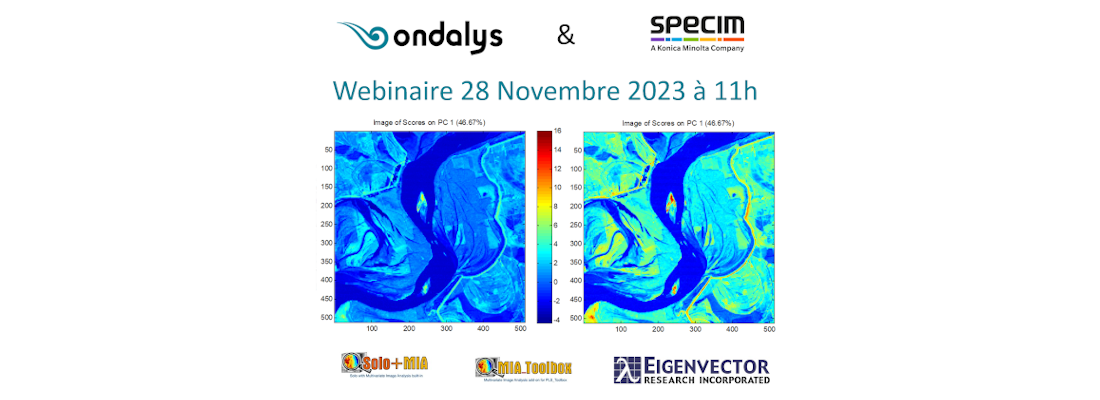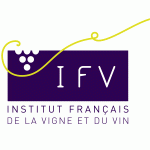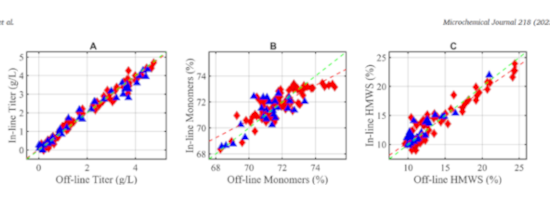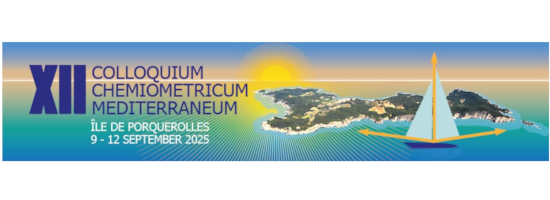
Attend our webinar (in French) :
How to process hyperspectral images ?

During this webinar, Julien Boyer from Ondalys and Mathieu Marmion from Specim, a manufacturer of hyperspectral imaging solutions, will present everything you need to know to optimize the acquisition and processing of hyperspectral images.
Discover step by step the methodology for analyzing hyperspectral images, from their acquisition, to the application of chemometrics / Machine Learning methods to images, including image processing methods for their segmentation.
Webinar program :
Webinar in French
- What’s a hyperspectral image ?
- Recommendation for image acquisition
- Hyperspectral image analysis methodology
- Application example for quantitative prediction
- Questions / Answers
Come and listen to the experts in Machine Learning and hyperspectral imaging, from Ondalys and Specim :
Julien Boyer – Ondalys and Mathieu Marmion – Specim
accompanied by Alice Croguennoc and Jordane Poulain – Ondalys


This webinar will be illustrated by a practical case of hyperspectral image processing carried out using SOLO+MIA from our partner Eigenvector Research Inc.

The application example presented comes from our collaboration on the VINIoT SUDOE project supported by INRAE and l’Institut français de la vigne et du vin (IFV).


Ondalys is a reseller of chemometrics, machine learning and hyperspectral image analysis software from Eigenvector Research Inc.
If your are interested in MIA_Toolbox or MIA+SOLO software, image processing software, contact-us.
To go further… What is the analysis of hyperspectral or multispectral images and how is Machine Learning interesting in the processing of these images?
A hyperspectral (or multispectral) imager is an imaging system for acquiring images in which each pixel contains data representing a broad electromagnetic spectrum (for example near infrared, infrared, Raman spectrum). Unlike traditional imaging which records only three spectral bands (red, green and blue) and only allows spatial analysis of colour, hyperspectral imaging records hundreds of spectroscopic wavelengths, allowing chemical analysis of products. This is why hyperspectral imaging is also called chemical imaging.
So, if you want to collect the same chemical information as that of a near-infrared spectrometer but spatialized, then a near-infrared hyperspectral imager is the suitable sensor! Because it makes it possible to obtain spatial chemical information, which is very useful in the case of heterogeneous samples (heterogeneous solid samples, powders, mixtures, etc.).
This technique finds applications in many industrial fields such as agriculture, the pharmaceutical and chemical sectors, remote sensing, and scientific research. For example, in agriculture, hyperspectral image analysis can detect crop diseases, optimize fertilizer use, and monitor plant growth. In the pharmaceutical industry, particularly in the quality control of raw materials and finished products, hyperspectral imaging makes it possible to characterize the homogeneity of powders and detect the presence of agglomerates, verify the integrity of lyophilisates of biotechnology products, prove the tablet compliance. In the field of environmental monitoring and remote sensing, it can detect and monitor water, air and soil pollution.
Hyperspectral image analysis has many advantages over traditional imaging techniques. It allows more precise identification of products based on their chemical composition, better discrimination between visually similar products, and more sensitive detection to subtle changes such as particle size or molecular composition. However, manually analyzing these images can be time-consuming and tedious, requires extensive expertise and is sometimes simply impossible! This is where chemometric methods and Machine Learning applied to spectroscopy and imaging come in to enable this analysis and provide classification results (e.g., compliant or non-compliant tablet) or quantification results (e.g. example, the distribution of sugar concentration in the grains of a bunch of grapes).



